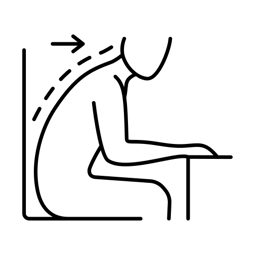In the fast-paced world of modern offices, where deadlines loom and tasks pile up, it’s easy to neglect how we sit and carry ourselves. However, the truth is that our posture plays a crucial role in our overall physical and mental wellbeing.

Imagine this: you’re sitting at your desk, hunched over your computer screen, shoulders slumped forward, and your neck craned to readjust your line of sight. Sound familiar? Unfortunately, this is a typical scene in many office settings. The sedentary nature of office lifestyles often leads to poor posture habits, which, if left unaddressed, can cause many problems.
So, why is good posture so vital? Proper spine alignment and positioning of your neck, shoulders, and hips are the foundation for optimal physical health. Conversely, bad posture can lead to musculoskeletal issues, such as back, neck, and shoulder pain, as well as potential long-term conditions like osteoarthritis.
Yet, the impact of poor posture extends beyond the physical realm. Did you know that your posture affects your energy levels and productivity too? Slouching can restrict blood flow and oxygenation, resulting in fatigue and decreased focus. Additionally, your posture is directly linked to your mood, confidence, and self-esteem. An upright posture can improve mental wellbeing and boost cognitive performance.
Fortunately, there are practical steps you can take to develop better posture habits and mitigate the negative effects of sedentary office work. You can make significant strides towards a healthier and more enjoyable office lifestyle by creating an ergonomic workspace, incorporating mindful movement and exercise into your daily routine, and consciously maintaining good posture throughout the day.
So, let’s dive in and discover how you can unlock the transformative power of optimal posture, paving the way for a happier, healthier, and more successful work life.

Consequences of Poor Posture
Musculoskeletal Issues
The most common problems with poor posture include back, neck, and shoulder pain.
When we slouch or hunch forward for extended periods, we strain the muscles and ligaments of our back. Over time, this can lead to chronic pain and stiffness, challenging even the simplest tasks. Additionally, poor posture can contribute to tension headaches and migraines, further exacerbating the toll it takes on our overall well-being.
Moreover, neglecting our posture can have long-term consequences. The misalignment caused by bad posture can gradually wear down the joints, potentially leading to osteoarthritis. It’s essential to recognise that poor posture isn’t just a fleeting discomfort but a potential catalyst for more significant musculoskeletal issues.
Reduced Energy and Productivity
When we slouch or slump in our chairs, our body’s natural alignment is compromised, leading to decreased blood flow and oxygenation. As a result, we may experience feelings of fatigue and sluggishness, making it harder to stay focused and engaged in our work.
Moreover, the impact of lousy posture extends beyond the physical realm. When we adopt a hunched posture, we tend to feel more withdrawn, less confident, and even experience a dip in self-esteem. On the other hand, an upright posture promotes a sense of confidence and positivity, improving our overall mood and mindset.
By neglecting our posture, we unwittingly hinder our energy levels, productivity, and emotional state. Recognising good posture’s role in our daily performance is the first step toward reclaiming our vitality and maximising our potential in the workplace.
The Importance of Good Posture
Physical Benefits
Firstly, good posture helps to alleviate and prevent musculoskeletal issues. Keeping our spine in a neutral position reduces the strain on our back muscles and ligaments, promoting a healthier and more resilient spine. This, in turn, reduces the risk of developing chronic pain, stiffness, and debilitating conditions like osteoarthritis.
Additionally, proper posture allows for optimal muscle function and balance. When we sit or stand with good posture, our muscles work together efficiently, distributing the load evenly. This reduces unnecessary tension and fatigue in specific muscle groups, enhancing overall comfort and preventing muscle imbalance.
Psychological Benefits
When we adopt an upright posture, with our shoulders back and heads held high, we convey confidence to others and send signals to our brains. This proper stance has been found to promote feelings of positivity, self-assurance, and empowerment, improving our emotional well-being.
Furthermore, good posture can enhance our cognitive performance. When we sit or stand with proper alignment, we allow for optimal blood circulation and oxygenation to our brain, supporting mental clarity, focus, and productivity. Maintaining an alert and upright posture can effectively combat the fatigue and brain fog often associated with poor posture.
Developing Posture Awareness and Tips for Improvement
Developing awareness of our posture and making conscious efforts to improve it is critical to breaking free from the negative habits that arise from sedentary office lifestyles. Here are some practical tips to help you improve your posture and make positive changes in your work environment:

Ergonomic Workspace
Creating an ergonomic workstation is essential for maintaining good posture. Consider the following adjustments:
- Chair
Ensure your chair supports your lower back correctly, has an adjustable height, and promotes upright sitting. Use a lumbar pillow or roll if necessary.
- Desk Height
Adjust your desk height so that your elbows are at a 90-degree angle when typing and your wrists are straight.
- Monitor Positioning
Position your monitor at eye level to prevent straining your neck. Use a monitor stand or adjust the height accordingly.
- Keyboard and Mouse
Keep your keyboard and mouse at a height that allows your forearms to parallel the floor, promoting a natural wrist position.
Mindful Movement and Exercise
Incorporate regular movement and exercise into your daily routine to counteract the effects of prolonged sitting and improve posture:
- Take Breaks
Stand up and stretch every 30 minutes. Set reminders or use apps that encourage regular movement throughout the day.
- Stretching
Perform simple stretches targeting your neck, shoulders, back, and hips to relieve tension and promote flexibility.
- Engage in Core-Strengthening Exercises
Strengthening your core muscles helps support your spine and maintain good posture. Include planks, bridges, and abdominal exercises in your fitness routine.
Posture Awareness
Developing awareness of your posture throughout the day is crucial. Implement these strategies:
- Mindful Check-Ins
Take everyday moments to check your posture. Adjust your positioning to maintain an upright alignment and avoid slouching.
- Use Supportive Props
Consider using ergonomic pillows, back supports, or posture correctors to provide gentle reminders and assistance in maintaining proper alignment.
-png.png?width=229&height=229&name=exercise%20(4)-png.png)
Lifestyle Habits
Beyond the office, adopt healthy habits that contribute to better posture:
- Regular Physical Activity
Regularly exercise, including activities that strengthen your back, core, and overall musculature. Incorporate cardio exercises to improve overall fitness.
- Balanced Diet and Hydration
Eat a nutritious diet for bone and muscle health. Stay hydrated to maintain healthy discs and tissues in your spine.
Conclusion
In conclusion, the significance of good posture for individuals with sedentary office lifestyles cannot be overstated. Poor posture can lead to musculoskeletal issues, reduced energy levels, and decreased productivity. On the other hand, maintaining proper alignment offers many benefits, including improved physical health, enhanced mood, and increased cognitive performance.
By developing posture awareness and implementing the practical tips and strategies discussed in this article, you can take proactive steps towards improving your posture and overall well-being. Create an ergonomic workspace, incorporate mindful movement and exercise into your daily routine, and practice regular posture check-ins. Remember to cultivate healthy habits outside the office, such as engaging in regular physical activity, maintaining a balanced diet, and staying hydrated.
So, start today. Sit up tall, roll your shoulders back, and align yourself with the transformative power of optimal posture. Your body, mind, and work will thank you for it. Here’s to a future of improved posture, increased vitality, and success in all your endeavours.
